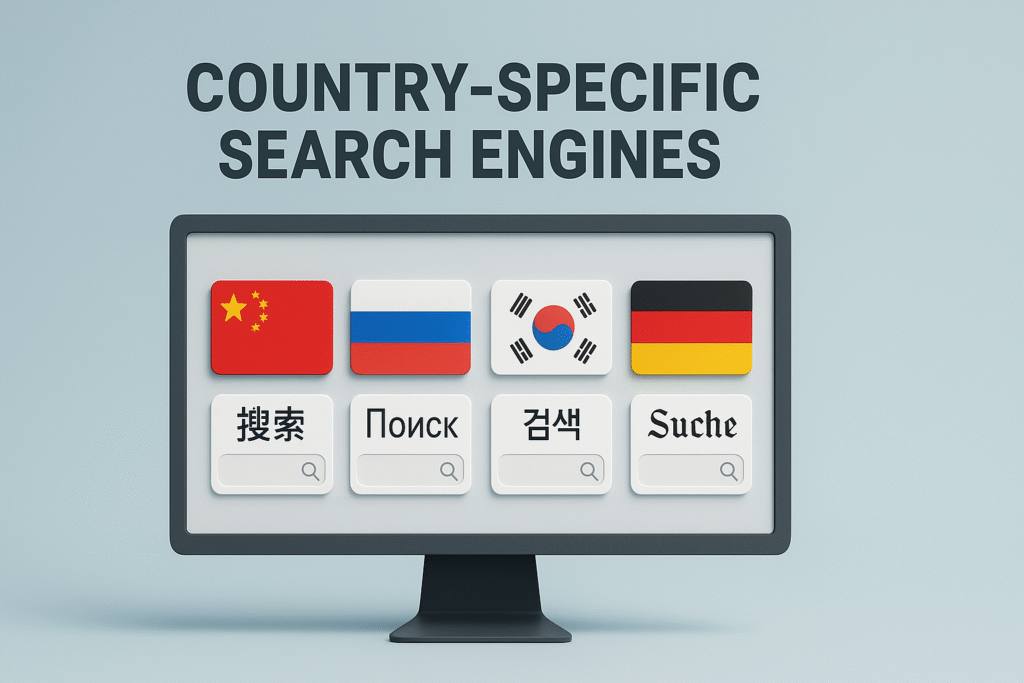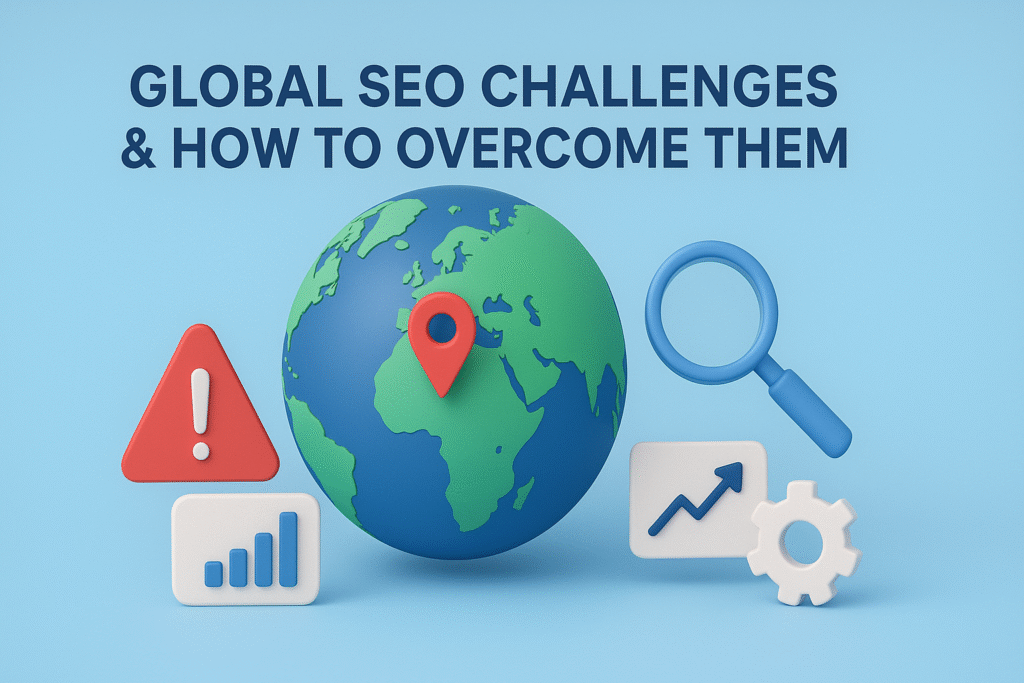In today’s borderless digital world, businesses are no longer confined to local markets. From startups to global enterprises, everyone wants to be visible on search engines worldwide. Yet, as exciting as international expansion sounds, there’s a complex web of technical and strategic hurdles to cross. These obstacles are what marketers call Global SEO Challenges.
If you’re trying to reach multiple countries, languages, and audiences, understanding these challenges — and knowing how to overcome them — becomes essential. This guide breaks down the most common global SEO hurdles and provides proven, actionable strategies to help your brand rank higher across different markets.
Table of Contents
Understanding Global SEO: What Makes It Different
Before diving into the challenges, let’s set the foundation. Global SEO, at its core, is the process of optimizing your website so it can perform well in multiple countries and languages. Unlike traditional SEO, which focuses on one language and region, global SEO ensures that your content, structure, and user experience adapt seamlessly to diverse audiences.
Global SEO is about visibility and relevance at scale. It’s not just about translating your site or running ads in new regions — it’s about delivering localized experiences that align with cultural context, language preferences, and search engine algorithms that vary from one country to another.
But the path isn’t smooth. From language barriers to technical missteps, Global SEO Challenges can hold back even the most optimized websites from achieving true international visibility.
The Biggest Global SEO Challenges in 2025
Let’s explore the key Global SEO Challenges businesses face today — and why they matter more than ever.
1. Language and Translation Barriers
Language remains one of the biggest roadblocks in international SEO. Many brands believe translating content word-for-word is enough, but that’s rarely true. Machine translations often miss nuances, cultural idioms, and tone — leading to awkward or even misleading interpretations.
When your content doesn’t read naturally in a target language, users bounce, and search engines take note. This reduces dwell time, affects rankings, and can damage brand credibility.
How to overcome it:
Use professional translators or native SEO writers who understand both language and local search intent. Prioritize transcreation over direct translation — meaning you adapt the message, not just the words. This ensures that your content resonates with your audience’s culture, humor, and expectations.
2. Cultural and Regional Relevance
Culture shapes behavior, preferences, and even how users search online. A campaign that performs well in the U.S. might not connect with audiences in Japan or Germany. Visual design, tone, colors, and even symbols can carry very different meanings across cultures.
How to overcome it:
Conduct thorough cultural research before entering a new market. Adapt your visuals, examples, and tone accordingly. For example, images featuring local people or references make your content feel relatable and trustworthy. Localization goes beyond words — it’s about connecting emotionally with the audience.
3. Geo-Targeting and Hreflang Implementation
Getting your hreflang tags right can make or break your international SEO performance. These tags tell search engines which version of a page should appear for users in specific regions or languages. Yet, many websites struggle with incorrect or missing hreflang attributes, leading to duplicate content issues or mismatched language pages.
How to overcome it:
Implement hreflang tags accurately on every international page and validate them using tools like Google Search Console or Screaming Frog. Each tag should reference all language variants and their corresponding URLs. It’s technical but crucial for ensuring users land on the right localized version of your site.
4. Country-Specific Search Engines

While Google dominates globally, it’s not the only player. Baidu in China, Naver in South Korea, and Yandex in Russia each have unique ranking algorithms and guidelines. Focusing only on Google can mean missing out on huge traffic opportunities in these regions.
How to overcome it:
Understand the top search engines in your target countries. For example, Baidu prioritizes local hosting and simplified Chinese content, while Naver values fresh, community-driven updates. Tailor your SEO approach to fit each search engine’s requirements to gain better visibility.
5. Domain and URL Structure Decisions
Choosing the right domain structure is one of the more strategic Global SEO Challenges. You can opt for country code top-level domains (ccTLDs), subdomains, or subdirectories — each with its pros and cons.
- ccTLDs (e.g., example.fr): Strong local trust but require separate SEO efforts.
- Subdomains (fr.example.com): Easier management but weaker signal for local relevance.
- Subdirectories (example.com/fr/): Consolidates authority but needs precise geo-targeting setup.
How to overcome it:
Align your structure with your goals and resources. If you want to establish strong local authority, ccTLDs are ideal. If you prefer central management, subdirectories offer better scalability. Consistency in structure helps search engines understand your international hierarchy.
6. Local Backlinks and Authority Building
Search engines heavily rely on backlinks to determine trust and authority. However, earning backlinks from local websites in multiple countries can be challenging. A site with only U.S. backlinks won’t rank well in Germany or Japan.
How to overcome it:
Build relationships with regional publishers, bloggers, and industry sites. Contribute guest posts, participate in local directories, and earn mentions from reputable local sources. A balanced link profile with geographically diverse backlinks enhances credibility in each target region.
7. Legal, Compliance, and Privacy Regulations
Privacy laws differ across the globe, and failing to comply can impact both SEO and reputation. For instance, GDPR in Europe and data protection laws in other regions dictate how user data should be collected and managed.
How to overcome it:
Audit your privacy policies and cookie management systems for each country. Ensure transparency and compliance in how you handle personal data. Websites that build user trust often enjoy higher engagement and better ranking signals.
8. Keyword Research Across Multiple Languages
This might sound simple, but it’s one of the most underestimated Global SEO Challenges. Translating keywords directly rarely works because search intent varies by language. A keyword popular in English might have a completely different equivalent in Spanish or French.
How to overcome it:
Perform native keyword research for each target region. Use tools like Google Keyword Planner, Ahrefs, or SEMrush with localized settings. Analyze competitors in local SERPs to identify what truly drives organic traffic there. Focus on search intent, not just translation.
9. Measuring Global SEO Performance
Tracking performance across multiple countries is complex. Traffic sources, conversions, and rankings differ by region. Without proper segmentation, you’ll never know which markets are growing and which need more attention.
How to overcome it:
Set up country-specific analytics in Google Analytics 4. Create separate reports for each market to monitor impressions, CTRs, and conversions. Use rank-tracking tools that support multi-location monitoring. The more granular your tracking, the faster you can identify issues and opportunities.
Proven Strategies to Overcome Global SEO Challenges
Now that we’ve covered the common roadblocks, let’s explore how to overcome them strategically. These actionable solutions will help you strengthen your international SEO presence and achieve consistent rankings across borders.
1. Hire Native Language SEO Experts
SEO is not just about keywords; it’s about understanding how people think and search. Native SEO professionals bring linguistic and cultural expertise that translation tools can’t replicate. They know what phrases local users trust, which tone engages them, and how intent differs from market to market.
Collaborating with native experts ensures your messaging feels authentic and your keyword targeting is accurate. It’s one of the smartest investments you can make in your international strategy.
2. Perfect Your Hreflang Implementation
Incorrect hreflang tags can cause ranking cannibalization — where the wrong page shows up for the wrong audience. Use automated tools to audit hreflang tags regularly. Make sure every language version references all others properly.
Pro Tip: Use canonical tags in combination with hreflang to avoid duplicate content penalties. Consistency in tagging will help Google display the most relevant version to each user.
3. Create Culturally Localized Content
People connect with brands that understand them. Localization goes beyond changing words — it’s about tailoring your message to local customs, holidays, humor, and social norms.
Incorporate local references or examples where appropriate. Even adjusting visuals to reflect regional attire or landmarks can significantly boost engagement. Localization builds emotional connection, which leads to better user retention and conversions.
4. Build Region-Specific Backlinks
Local backlinks act as digital votes of confidence in each market. Start by identifying local directories, media outlets, and industry blogs relevant to your niche. Offer to contribute valuable content or insights that benefit their audiences.
When search engines see backlinks from trusted sites within a specific country, they’re more likely to rank your website higher for that region’s users.
5. Choose the Right Domain Structure for Your Global Goals

Your domain structure impacts how search engines interpret your website’s international targeting.
- If you want country-specific dominance, ccTLDs like .in or .fr work best.
- If you want global brand consistency, subdirectories are easier to maintain.
Regardless of your choice, maintain consistent URL formats and internal linking. A clean, organized structure helps both users and search engines navigate effectively.
6. Optimize for Local Search Engines
In regions like China or South Korea, focusing only on Google means ignoring most users. Instead, tailor your strategies to the dominant local platforms. For example:
- Baidu: Prioritize simplified Chinese content and fast local hosting.
- Yandex: Focus on technical SEO and structured data accuracy.
- Naver: Include blogs and community-driven posts for visibility.
This approach maximizes your visibility where it truly matters.
7. Localize Technical SEO Settings
Technical optimization often decides whether your localized efforts succeed. Set up geographic targeting in Google Search Console. Use separate XML sitemaps for each region and ensure canonicalization doesn’t conflict with hreflang.
Also, host your website on fast, globally distributed servers or use a reliable CDN to reduce latency for users worldwide.
8. Monitor Global Performance Consistently
Don’t rely on global averages — they hide local fluctuations. Use SEO dashboards that allow country-level insights. Track which markets generate the most conversions and which pages underperform in specific languages.
By doing this, you can refine your strategy, double down on winning markets, and fix weak ones faster.
Advanced Tips for Scaling Global SEO
Once your foundation is strong, scaling becomes easier. Here are a few advanced tactics to take your global SEO strategy further:
- AI-powered localization tools: Use AI-assisted platforms to speed up content translation without losing tone or meaning.
- CDN integration: Deliver content faster globally, improving Core Web Vitals.
- Automated keyword tracking: Monitor rankings by region automatically using advanced SEO tools.
- Centralized content strategy: Create a global brand guide to maintain voice consistency while allowing regional flexibility.
These tools and approaches help maintain brand harmony across borders while improving efficiency.
Common Mistakes to Avoid in Global SEO
Even experienced marketers fall into traps that limit global reach. Watch out for these errors:
- Ignoring cultural sensitivity and regional tone.
- Over-relying on English content for non-English markets.
- Neglecting hreflang validation and canonical tags.
- Using the same backlink strategy for every region.
- Forgetting to test localized pages before launch.
Avoiding these mistakes saves time, money, and credibility in the long run.
Future of Global SEO: Trends to Watch
The future of international search is evolving rapidly. Here are key trends shaping what comes next:
- Multilingual voice search: As voice assistants grow, optimizing for local languages in natural speech will become vital.
- AI-driven localization: Machine learning will help predict cultural preferences and search intent across languages.
- Privacy-first SEO: Compliance with local laws like GDPR and CCPA will directly influence visibility and trust.
- User experience focus: Faster load times and local usability signals will become key ranking factors worldwide.
Staying ahead of these trends will give you a competitive edge as algorithms and audiences evolve.
Conclusion
Expanding globally is one of the most rewarding yet complex endeavors in digital marketing. The key to success lies in understanding and overcoming the Global SEO Challenges that come with international growth.
From technical issues like hreflang tags and domain structures to human elements like culture and language, every factor plays a role. By localizing content, building region-specific authority, and staying compliant with privacy laws, you can create a powerful presence in multiple markets.
When you approach global SEO strategically, you’re not just ranking higher — you’re building meaningful connections with audiences around the world.
FAQs
Q1. What are the biggest Global SEO Challenges for businesses today?
The main challenges include language translation, cultural adaptation, hreflang implementation, keyword research, and tracking performance across multiple countries.
Q2. How can I overcome language barriers in Global SEO?
Use native translators or local SEO professionals who understand the target culture and search intent, ensuring your content reads naturally.
Q3. Why is hreflang important in international SEO?
Hreflang tags guide search engines to display the right language or regional page to users, avoiding duplicate content and mismatched results.
Q4. What’s the best domain structure for global websites?
It depends on your goals. ccTLDs build local trust, subdomains offer flexibility, and subdirectories consolidate SEO authority.
Q5. How can I measure the success of a global SEO campaign?
Use region-specific analytics and rank tracking tools to monitor performance, conversions, and engagement by country or language.



